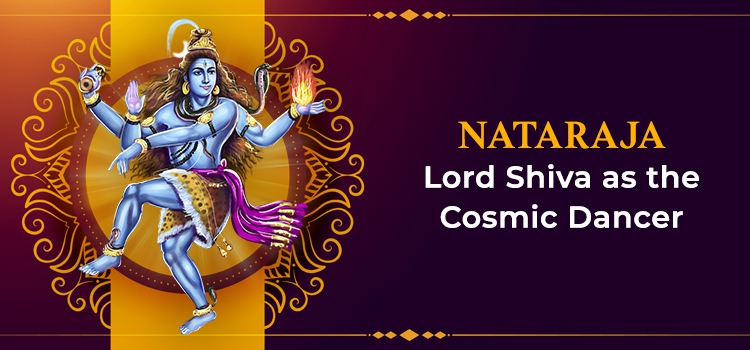Nataraja – Lord Shiva As the Cosmic Dancer
Brahma, Vishnu, and Shiva are the deities who form the Hindu Trinity or Trimurtis. Each god has a specific role. Brahma creates, Vishnu preserves, and Shiva destroys.
But the destruction unleashed by Lord Shiva is to make way for the new by getting rid of the old.
Shiva As the Cosmic Dancer
The Maha Pralaya, or Great Flood, signifies the end of the world, with all of creation dissolving into the Great Void. At this point, Shiva performs Shiva Tandav, the cosmic dance to release the destructive energies that are needed to dismantle all creation. In this form, he is Nataraja, the cosmic dancer.

It is said that there are 19 avatars of Shiva. But Lord Nataraja is not actually an avatar. It is Shiva himself who is the dancer.
Nataraja’s apocalyptic dance represents the interplay of dynamic and static divine energy flow. Energy is neither created nor destroyed, says science. The destruction that Shiva enacts through his cosmic dance leads to recreation, and thus the cycle continues.
Nataraja performs his cosmic dance in an aureole of fire. This leads to wild thunderstorms all around the world. Everything is affected, the Earth, the Sun, the Moon, and the heavenly bodies. The dancing Shiva is depicted with matted locks of hair, marks of ash on the forehead, and holding the damaru and trident. He lifts his left leg, and his right leg hovers above a demon who symbolizes ignorance.
The Shiva Tandav Stotram, composed by Ravana, beautifully describes this cosmic dance of Nataraja.
Nataraja: The Lord of Dance
According to myth, Nataraja appeared near Chidambaram, a town that lies at the confluence of two rivers, Vellar and Cooleran. A group of sages was causing a lot of problems by doing black magic. They even tried to control the gods. So, Lord Shiva appeared in their midst as a handsome beggar called Bhikshatanar with the aim of teaching the sages a lesson and curbing their arrogance. The sages’ wives were smitten with him, and even Vishnu’s Mohini avatar fell for his charms.
Seeing their wives lusting after Bhikshadanar, the sages became angry. They threw snakes at him, which he turned into ornaments that he wore on his body. Then they sent a tiger with magical power after him. But he tore the tiger’s skin and wore it as his loincloth. Next, they sent an elephant from their sacrificial fires, but Bhikshadanar killed it. When they realized that nothing was working against Bhikshadanar, they combined all their powers and gave birth to a Rakshasa called Apasmara, who represented arrogance and ignorance.
But Bhikshadanar blithely stepped on the Rakshasa and began to dance gracefully. This ecstatic dance is the Shiva Tandav or cosmic dance. And Shiva got the moniker of ‘Nataraja’, the King or Lord of dance. When they saw him dance, it dawned on the sages who the beggar really was. This put an end to their ego and arrogance.
Thus, the purpose of Shiva’s dance is to free the souls of human beings from the snare of illusion. He destroys the evil that lurks within them so that they can attain salvation and freedom from the cycle of birth and death.
Two Types of Dance
Shiva performs 2 kinds of dances. One is the Rudra Tandava, and the other is Ananda Tandava. Shiva is at his most ferocious during Rudra Tandava, which signifies the destruction of the cosmos. But the destruction is constructive because it leads to new creation.
Ananda Tandava, or the dance of bliss, is when Shiva’s intrinsic nature emerges as Shivam. This is his purest form, Satchidananda. Rudra and the Ananda Tandava reflect the two distinct natures of Shiva.
All movement in the universe flows from Shiva’s dance. The site of his dance, Chidambaram, which is supposedly the center of the universe, is actually within the heart.
Symbolism of Nataraja
As a symbol, Nataraja combines Shiva’s different roles - creator, preserver, and destroyer - in one image. Each element in the Nataraja image carries a unique meaning.
The Damaru that is in his upper right-hand makes the first sound of creation. The divine fire (Agni) on the upper left-hand, represents the apocalypse. His lower right-hand displays the Abhayamudra, the gesture of protection that removes all fear. His left hand displays the gesture of Gaja hasta, which represents salvation and liberation.
His right foot is on the dwarf figure, Apasmara Purusha, who is the symbol of illusion and ignorance that hide reality and truth. Shiva’s matted hair flies about during the dance. His energy and wildness disperse; his locks contain a skull, a datura flower, and a crescent moon to indicate that Shiva is omnipresent but invisible.
The holy Ganges river resides in his hair, which signifies both creation and destruction. His two eyes represent the Sun and the Moon. His third eye represents knowledge. Together, they signify the equilibrium of the three Gunas- Sattva, Rajas, and Tamas.
As Nataraja, Shiva dances within a flaming halo (Prabha Mandala) that represents Time and is presented in a circle, as Time is cyclical and endless. Though the cosmic dance releases passion, energy, and wildness, Shiva’s face wears a smile.
Lasya Dance
Goddess Parvati performs the Lasya, a gentle dance called ‘Ananda Tandavam’, or dance of bliss, after the process of destruction. She performs this dance to enable the re-creation of the world after its dissolution. Both dances take place in one’s Chitrambalam (the sky of one’s mind), which is the center of consciousness at the altar of one’s heart.
The Tandav dance of Lord Shiva requires careful timing and precision. If it is too early or late, it will disrupt the entire balance of the universe. Once, Shiva forgot himself and performed the dance too early. This had catastrophic consequences.
Being the god of Time and creation, he destroys the universe every 2,160,000,000 years, and he e supposedly creates a brand new universe by drumming his damaru.
Nataraja Worship
The temples of Nataraja are called Pancha Sabhai Sthalangal. At all these places, he is believed to have performed the Tandava. ‘Pancha’ means ‘five’, ‘Sabhai’ means ‘hall’, and ‘Sthala’ denotes ‘place’. All these temples lie in Tamil Nadu, south India. The 5 dances were Kali Tandava at Rathinachabai in Vada Aaranyeswarar Temple, Sandhya Tandava at Vellichabai in Meenakshi Amman Temple, Ananda Tandava at Porchabai in Thillai Natarajar Temple, Chidambaram, Muni Tandava at Thamirachabai at Nellaiappar Temple and Tripura Tandava at Chithirachabai in Kutralanathar Temple. These temples are renowned for Nataraja worship.




















